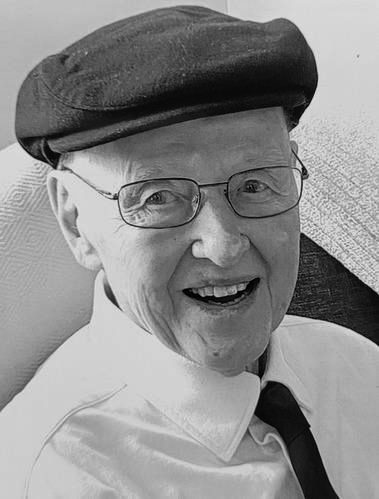
July 27, 2024. Raymond Arthur Detter passed away Saturday night in his sleep. His loss has left a broad and complex community without its center. This community was not a city, municipality, political cause, or lifestyle—but it touched all of these things. Ray was the beating heart of a community of his own forging. Through the sheer force of his will and wit, he inspired others to participate and become passionate about a constellation of interests he found important.
Ray’s long life is all the more remarkable for all that he managed to pack into it. Ray was born July 16, 1931. He grew up with his widowed single mother, his sister Sally, and his brother Robert. They were a family of extremely modest means, but Ray’s sharp mind and strong independence began to propel him early in his life.
Ray was an excellent if rebellious student in high school. After graduating from Cass Tech in Detroit and two years in the Army, Ray entered Wayne State University with the help of the G.I. Bill. It was during his undergraduate years that Ray developed an interest in government and politics. His curiosity about different governing systems—namely Communism—nearly had him expelled and discharged from the Army at one of the more paranoid times in our country’s history. Ray joined Students for the United Nations while at Wayne State, and was a student guide to none other than Eleanor Roosevelt while she visited Michigan as an educational ambassador for the United Nations.
He graduated from Wayne State with a teaching degree and focus in history. Ray subsequently taught at local schools in Detroit for a few years. Ray moved to Ann Arbor for graduate school in the early sixties. It was here at the University of Michigan where he earned his Masters and PhD in history and American culture. Ray made some of his closest and lifelong friends while a student at U-M. He remained in Ann Arbor after his degrees to teach at the university.
While teaching history and American culture, Ray’s interest in history became a passion for antiques. That passion became an expertise, as Ray excelled at anything that caught his attention. Ray’s knowledge of antiques was sought after by lawyers who were involved in resolving complicated family estates. Little by little Ray’s “hobby” grew to be a larger part of his life and his income than his teaching career. By the time UCLA sent him an offer to move to California to be a professor, Ray already knew he loved Ann Arbor too much to leave, and his side business replaced his teaching career.
Ray spent the rest of the ’60s and the early ’70s working in Ann Arbor as an antique dealer and visiting the Bushalas—the family of his best friend in Detroit, whom he adopted as his own. Ray’s love of history found a new outlet in real estate. Ray began to buy, sell, and preserve historic houses in Ann Arbor. He built this interest into a group of other owners who were passionate about historic homes, and together they created Ann Arbor’s first historic districts as well as the Historic District Commission. Ray later went on to document the lost historic structures of Ann Arbor by creating displays throughout the city showing old photos of these buildings and telling the stories of their past.
Raymond’s childhood interests in government found new energy in the city of Ann Arbor. Here, he was a constant presence at city council meetings, planning commissions, and various large-scale endeavors of the city to form its master plans for the future. Once again, Ray’s passion became expertise. Ray came to wield a power easily equal to any elected official in the city, merely because he knew the city’s plans, reports, and bylaws better than anyone else. He became a strong advocate for increasing the number of downtown residents at a time when downtowns across the country were drying up and migrating to suburban malls. Ray was part of the inception of the DDA (Downtown Development Authority) and remained the chair of the Citizens Advisory Council of the DDA for most of the years of its existence. The people who were part of these various commissions and organizations invariably became friends with Ray. His gregarious nature and social ease made any of the projects he worked on more like parties than work. These parties were a regular occurrence and took place in Ray’s backyard. If you were an aspiring politician in Ann Arbor, it was a must that you appear at Ray’s backyard in June for the Old Fourth Ward Neighborhood party. If you were editing the text of a history book about Ann Arbor, much of that work was going to happen in Ray’s backyard. If you were a developer hoping to build something in downtown Ann Arbor, an essential part of your process was going to be meeting Ray in his backyard to see what he thought of it. All of these groups—these different interests—were communities within a community. Ray’s Community.
Each and every Art Fair, for the last 55 years, Ray’s oldest friends and schoolmates from Michigan would return from places around the world, They came from illustrious careers in academia, the arts, architecture, industry, and politics. They came to Ray’s backyard to visit their old friend, to celebrate each other, and to celebrate Ray’s birthday. This year the party was much smaller. There are many of these wonderful people who left us before Ray. Others have a much harder time getting around now.
The results of Ray’s prodigious talent and energy remain all around us. The historic districts he helped create are here today. The displays of historic Ann Arbor stand throughout the city. There are tours each year of local high school students where these displays and their stories are told to the next generation. The many friends that Ray brought together through his warmth and humor banded together heroically to help him through his final years of health problems. The wonderful community he built continues on and lovingly remembers him.
Ray was preceded in death by his mother, Helen Hooley, and his brother Robert (Bob) Detter, as well as many good friends. Ray is survived by his sister Sally Steffen, his nieces and nephews, and close friends.
In lieu of flowers, donations can be made to the Ann Arbor Historical Foundation, The Ray Detter Award, sent to H. Scott Diels at 1414 Iroquois Pl., Ann Arbor, MI, as well as to the Ann Arbor Community Foundation, Historical Street Exhibit Fund, sent to 301 N. Main St., Ann Arbor, MI 48104.

